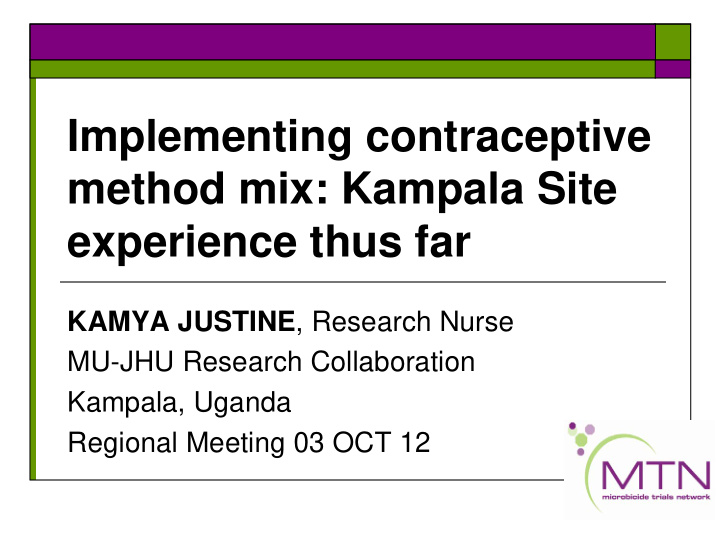



Implementing contraceptive method mix: Kampala Site experience thus far KAMYA JUSTINE , Research Nurse MU-JHU Research Collaboration Kampala, Uganda Regional Meeting 03 OCT 12
Outline Introduction Preparatory Activities Training Implementation Outcomes Challenges Conclusion/Recommendations
Introduction Contraceptive method mix – Increase uptake of other contraceptive methods not readily available by ensuring availability, accessibility & utilization. Purpose of Method mix is to enable populations have access to a range of contraceptive methods.
Preparatory Activities Site selected a nurse and a doctor to join the Contraceptive Action Team (CAT). On 7-8 June 12, Dr. Betty and I together with the steering committee member (Dr.Clemensia) attended the MTN contraceptives Action meeeting in Johannesburg After the meeting the nurse and doctor were declared the contraceptive experts
Preparatory Activities cont’d Procurement of instruments Guidance from Mulago hospital family planning clinic
Training Report and action plan approved by site leaders On14 Jun12, refresher training on all contraceptive methods by the Mulago FP expert 05 to 06 Jul 12 counselors had refresher training on counseling messages
Training cont’d Training of key staff Weekly rotations by the study staff (nurses and doctors) for practical sessions at the family planning clinic
Implementation Obtaining F/P supplies from the Mulago F/P unit Site is now providing all methods in real time except surgical sterilization. Counseling involves going through all the methods even if participant is already on a method with emphasis on dual contraception
Counseling session
Implementation cont’d One of the agenda items at weekly study meetings Attend contraceptive conference calls where sites exchange ideas, experiences, challenges
Contraceptive use at screening for ASPIRE (n=59) ( Data from 27 Jul 12 to 20 Sep12) 51% 25 Numbers of participants 20 29% 15 Potential 10 Enrolees (n=49) 12% 50% 5 30% Screened out 20% 4% (n=10) 2 % 2 % 0% 0% 0% 0 Method
Outcomes Contraceptive Uptake for those on none at baseline (n=14) 42.8% Percentage of Participants 45.0% 40.0% 28.6% 28.6% 35.0% 30.0% 25.0% 20.0% 15.0% 10.0% 0.0% 0.0% 5.0% 0.0% Depo COCs IUCD Implants Sterilization Methods
Outcomes cont’d Switches in contraceptive methods Depo to implants: 2 COCs to Depo: 2 COCs to Implant: 2 COCs to IUCD: 1
Outcomes cont’d Most participants had not received adequate counseling on these methods from their providers Some were using the methods they were using due to fewer options at their clinics Some participants are comfortable with their current methods Some had stopped using methods due to side effects and good number were not using any method
Challenges Myths and misconceptions affecting decision making Fear of procedures i.e. IUCD and implant insertion
Conclusions /Recommendations For successful implementation of contraceptive method mix; Liaising with already existing and functional f/planning clinics is crucial Trainings/refresher trainings for staff are needed Regular evaluations of activities is needed Need to minimize on delays
Acknowledgements Study Participants Mulago Family Planning Clinic Contraceptive steering committee MTN is funded by NIAID (5U01AI068633), NICHD and NIMH, all of the U.S. National Institutes of Health
Recommend
More recommend